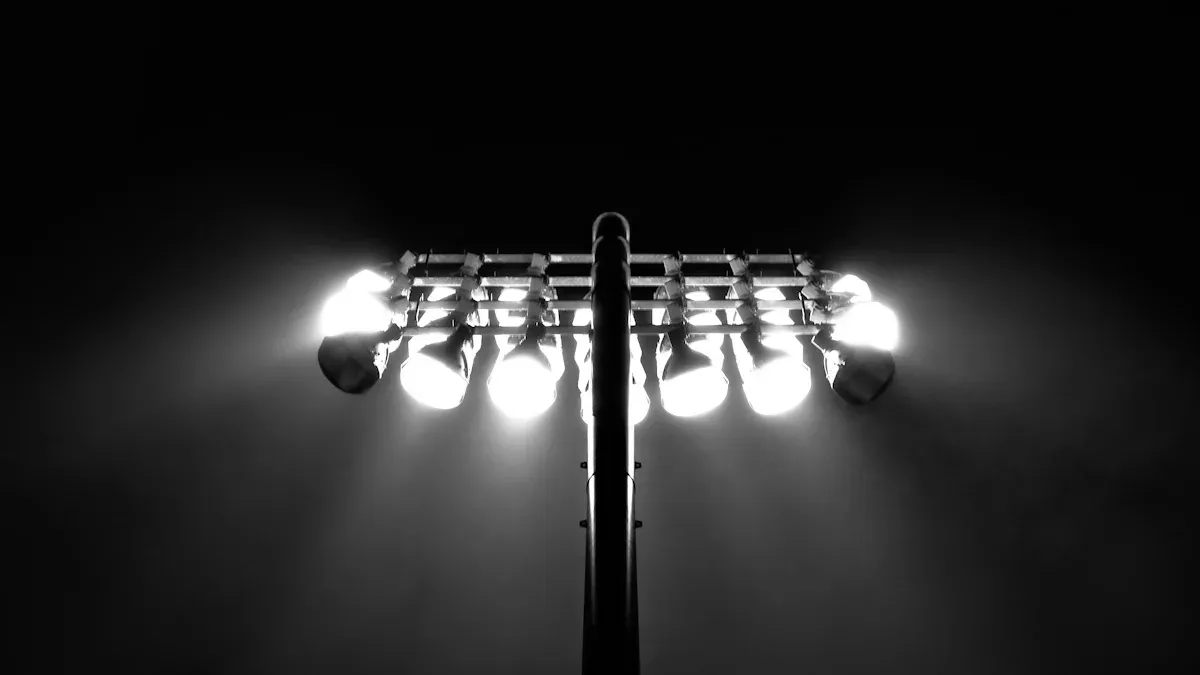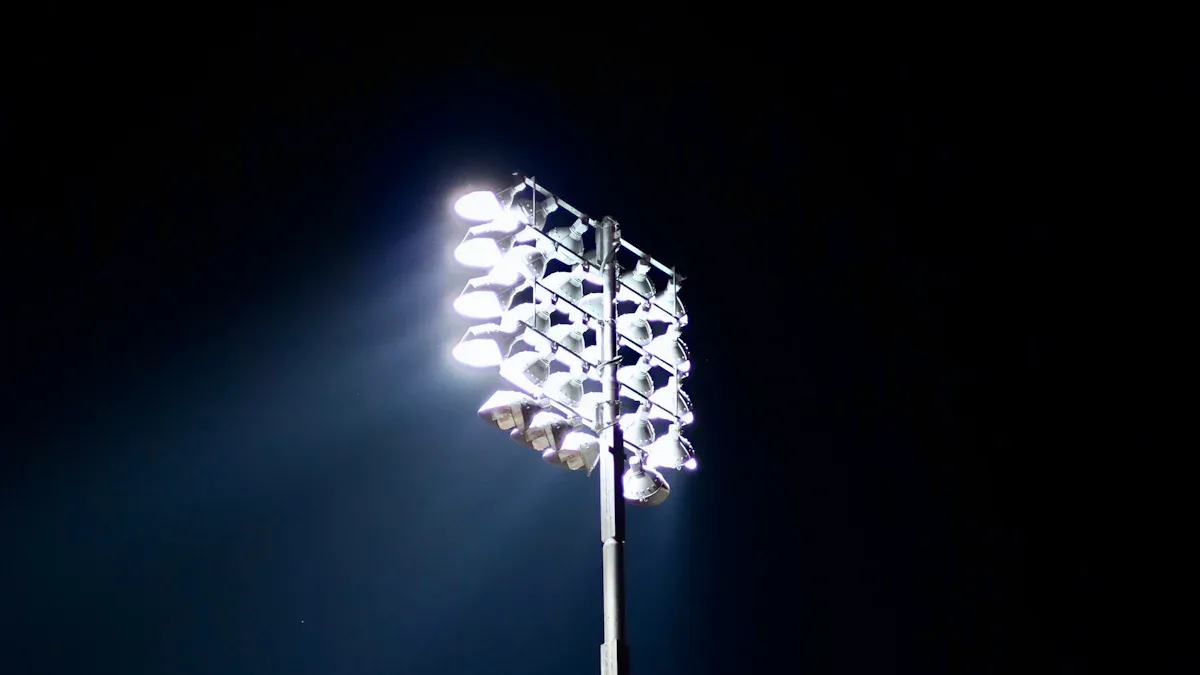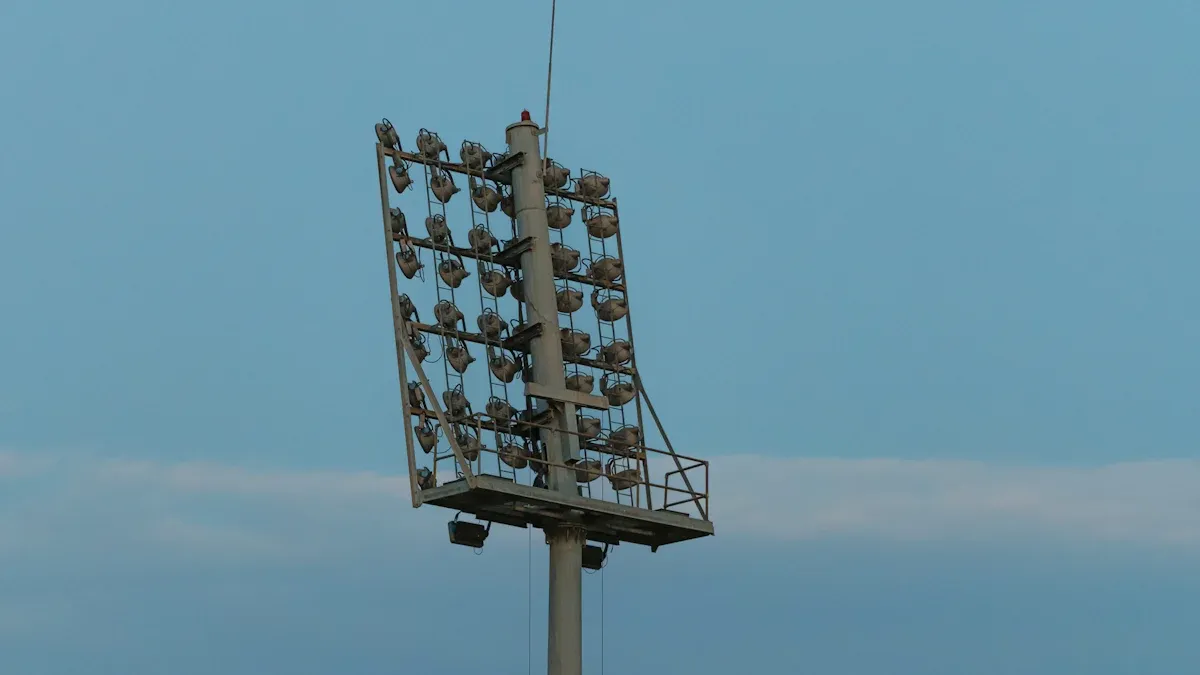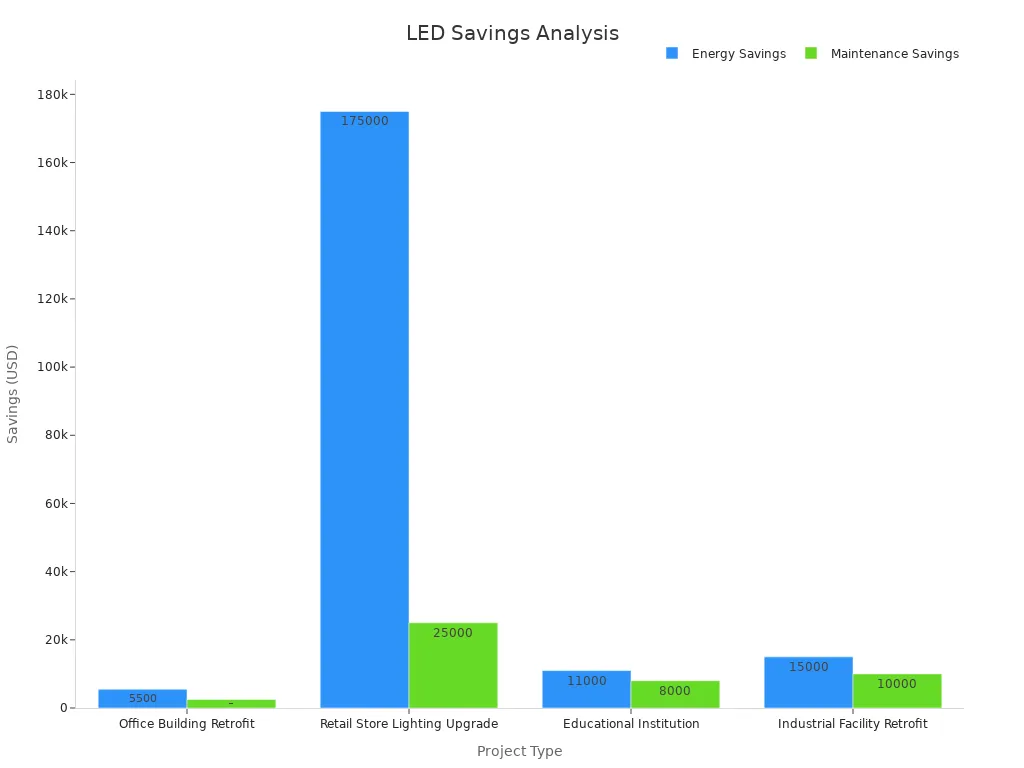Area Lighting LED Solutions for Energy Efficiency and Maximum Illumination

You want brighter, safer spaces and lower bills. LED area lighting leads the way with unmatched efficiency and powerful illumination for any outdoor or large area. Did you know LED lighting can cut energy costs by up to 80%? LEDs last over 50,000 hours, while old bulbs burn out fast. Check out the numbers below:
Lighting Type | Typical Lifespan (hours) |
|---|---|
LED (quality white light) | 50,000+ |
Incandescent bulbs | 1,000 |
Compact fluorescent | 8,000 - 10,000 |
Efficient linear fluorescent | Up to 30,000 |
With LED lighting solutions, you get less hassle, less maintenance, and real savings. The right area lighting setup transforms any space. Whether you’re upgrading your Home, business, or Product displays, smart LED lights make a difference. Learn more About Us and discover the best Led Light for your needs.
Key Takeaways
LED area lighting saves up to 80% energy and lowers electricity bills quickly.
LED lights last much longer than traditional bulbs, reducing maintenance and replacements.
LEDs provide bright, even light that improves safety and shows colors clearly.
Using LED lighting helps protect the environment by cutting emissions and waste.
Smart LED features like motion sensors and dimming boost savings and convenience.
Key Benefits
Energy Savings
You want to save money and help the planet. LED area lighting makes that easy. When you switch to energy efficient LED lights, you can see up to 80% energy savings compared to old lighting systems. That means you spend less on your electricity bill every month. Here’s how these savings add up:
Cities like Barcelona and Amsterdam have saved millions each year by upgrading to LED area lighting with smart controls.
Motion-activated streetlights can cut energy use by 50–60% during quiet hours.
Adding smart features like dimming and scheduling boosts energy savings from 40% up to 70% or more.
In warehouses and schools, LED retrofits have delivered 68% to 75% energy savings, especially when paired with controls.
You get more than just lower bills. LEDs use less energy, so they help reduce demand on the power grid. That’s good for everyone. If you want to start reducing energy costs right away, LED area lighting is the smart choice.
Long Lifespan
LEDs last much longer than traditional lights. You won’t have to climb ladders or call for replacements nearly as often. Take a look at how different lighting types compare:
Lighting Technology | Typical Lifespan (hours) | Failure Mode |
|---|---|---|
LEDs | Gradual dimming (not sudden failure) | |
Incandescent Bulbs | 1,000 to 2,000 | Burn out quickly |
Fluorescent Bulbs | 7,000 to 15,000 | Flicker and lose brightness |
Halogen Flood Lights | ~2,500 | Need frequent replacement |
LED area lighting keeps working for years, even in tough environments. You’ll notice fewer outages and less hassle. Most LEDs fade slowly over time, so you can plan for replacements instead of dealing with sudden blackouts. Regular cleaning and quick checks help your lights last even longer.
Tip: Keep a simple maintenance log. It helps you spot issues early and keeps your area lighting shining bright.
Light Quality
You want your spaces to look great and feel safe. LEDs deliver improved light quality that makes colors pop and details stand out. Lab tests show that LEDs reach a color rendering index (CRI) of 90 or higher, which means they show colors almost as well as natural sunlight. That’s better light quality than most old bulbs.
LEDs produce bright, even light measured in lumens.
You can pick the color temperature you like, from warm to cool.
LEDs keep their brightness steady, so you don’t get dark spots or flicker.
In offices and classrooms, LED lighting gives you clear, comfortable light that helps people see and work better. In outdoor areas, you get safer walkways and parking lots with fewer shadows.
Environmental Impact
LED area lighting helps protect the environment. When you use less energy, you lower greenhouse gas emissions. Studies show that switching to LEDs can cut CO2 emissions by millions of kilograms each year. You also avoid toxic waste, since LEDs don’t contain mercury like some old bulbs.
DC LED systems reduce cooling needs, saving even more energy and cutting carbon emissions.
Municipal upgrades to LED streetlights mean fewer bulbs in landfills and less hazardous waste.
Life cycle studies show that LEDs can reduce environmental footprints by over 60%, and even more when paired with renewable energy.
You make a real difference by choosing energy efficient LED lighting. You help your community save money, use less energy, and keep the planet cleaner for the future.
Types of Area Lighting

Choosing the right area lighting makes a big difference in how your space looks and feels. Let’s break down the main types of LED area lights you can use for outdoor and indoor spaces.
High Bay LED
You see high bay LED lights in places with tall ceilings, like warehouses, gyms, and big retail stores. These lights shine bright and spread light evenly across a large area. LED high bay lights use up to 80% less energy than old bulbs and last much longer. They turn on instantly, so you never wait for full brightness. Many top brands now offer high bay LEDs with over 200 lumens per watt, which means you get more light for less power. You also save money on maintenance because you don’t have to change bulbs as often.
LED Floodlights
LED floodlights work great for lighting up outdoor spaces, parking lots, sports fields, and building facades. These spotlights give you strong, wide beams that cover large areas. You can use them for security or to highlight special features. Modern LED floodlights often come with smart controls and sensors, so the lights only turn on when needed. This saves energy and keeps your area safe.
LED Wall Packs
If you want to light up the outside of a building, LED wall packs are a smart choice. You mount these lights on walls to brighten walkways, entrances, and loading docks. They give you steady, even lighting and help people feel safe at night. Many wall packs now include motion sensors or daylight sensors, so you use less energy when no one is around.
LED Pole Lights
LED pole lights are perfect for streets, parking lots, and pathways. You see them on tall poles along roads and in parks. These lights give you bright, even coverage and help drivers and walkers see clearly. LED pole lights often use smart dimming features, which means they use less power when the area is empty. This helps cities and businesses save money and energy.
LED Landscape Lighting
Want to make your yard or garden stand out? LED landscape lighting lets you highlight trees, plants, and pathways. You can use spotlights to show off special features or deck and step lighting to make outdoor stairs safer. LED landscape lighting is flexible—you can place it almost anywhere. It works well for pathway lighting, deck and step lighting, and even for accenting water features. Many systems now use sensors to adjust brightness based on daylight, which saves energy and keeps your outdoor space looking great.
Tip: Use LED landscape lighting to guide people along pathways and steps. This makes your outdoor area safer and more inviting.
Solar-Powered LED
Solar-powered LED lights are a great choice for off-grid areas, parks, and places where you want to save on electricity. These lights use the sun’s energy during the day and shine at night. You don’t need to run wires or pay for power. Solar LED lights work well for pathway lighting, deck and step lighting, and even spotlights in gardens. They help the environment and lower your energy bills.
Selecting the right type and layout of LED area lights is key. You get the best results when you match the lighting to your space and needs. Many case studies show that using smart controls and sensors with LED area lighting leads to big energy savings and better comfort. When you plan your lighting, think about where you need the most light and how you can use features like motion sensors or daylight sensors to save even more.
Energy Efficient LED Features
When you look for the best energy-efficient solution, you want features that boost both performance and savings. Let’s break down what makes energy efficient LED area lighting stand out.
Lumens and Efficacy
Lumens tell you how bright a light is. Efficacy means how much light you get for each watt of electricity used. You want high lumens per watt for the best efficiency. Many LED ceiling lights now reach over 100 lumens per watt. Some high efficiency LED fixtures in places like data centers even hit 150 to 200 lumens per watt. That means you get more light while using less energy.
LEDs use only about 20-25% of the electricity that old incandescent bulbs need.
You can save over 75% on your lighting bills by switching to LED.
LEDs turn more than 90% of the energy they use into visible light, not heat.
The Federal Energy Management Program says that a higher luminaire efficacy rating (LER) means better efficiency. So, when you shop for LED lights, check the lumens per watt. The higher the number, the more energy you save.
Wattage
Wattage shows how much energy a light uses, not how bright it is. With LED lighting, you get more brightness with less wattage. For example, a 7-watt LED can shine as bright as a 50-watt incandescent bulb. That’s a huge jump in efficiency.
If you want to cut your energy use, always compare the lumens, not just the watts. Lower wattage with the same or higher lumens means you’re getting a more energy-efficient LED. This helps you save money and reduce your carbon footprint.
Tip: Don’t just look at watts. Always check the lumens to see how bright your LED will be.
Color Temperature
Color temperature changes how a space feels. It’s measured in Kelvin (K). Warm light (2700K-3000K) feels cozy, while cool light (4000K-5000K) feels crisp and helps you focus. You can pick the right color temperature for each area. For example, use warm white for relaxing spaces and cool white for work zones.
Lumens and color temperature work separately. You can have a bright, warm light or a dim, cool light. This flexibility lets you create the perfect mood and function for any space. LED fixtures make it easy to choose the color temperature that fits your needs.
Controls and Sensors
Smart controls and sensors take your energy savings to the next level. Motion sensors turn lights on only when someone is there. Daylight sensors adjust brightness based on natural light. These features help you use less energy without thinking about it.
Feature | Benefit |
|---|---|
Motion Sensors | Lights turn on only when needed |
Daylight Sensors | Adjust brightness to match sunlight |
Dimming Controls | Lower light levels to save energy |
Scheduling | Set lights to turn on/off at certain times |
ENERGY STAR certified LED products often include these smart features. They meet strict standards for efficiency and performance. You get reliable lighting that saves energy every day.
Durability
You want lights that last and stand up to tough conditions. LED fixtures are built for durability. They handle weather, dust, and bumps better than old bulbs. ENERGY STAR certification also checks for thermal management, so your LEDs keep shining bright for years.
LEDs don’t burn out suddenly. They fade slowly, giving you time to plan replacements. Many fixtures use a process called “binning” to make sure you get consistent color and brightness. Directional lighting means LEDs shine light exactly where you need it, so you waste less energy.
Note: Look for weather-resistant and long-lasting LED fixtures for outdoor or industrial spaces. This keeps your area safe and bright, no matter the conditions.
When you choose energy efficient LED lighting, you get more than just lower bills. You enjoy better light, less hassle, and a smaller impact on the environment. These features make LED the top choice for anyone who wants an energy-efficient solution that delivers maximum illumination.
Application Tips
Installation
You want your led upgrades to go smoothly. Start by picking the right led fixtures for your space. Check the color temperature, lumen output, and beam angle. These details help you get the best light and efficiency. Always follow the manufacturer’s instructions for installation. Good ventilation keeps your lights cool and lasting longer. For retrofit projects, make sure your wiring matches the new led system. If you install outdoor lights, use weather-resistant fixtures to handle rain and dust.
Tip: Place your led fixtures so you avoid glare and get even light across the area.
Placement
Smart placement makes a big difference in how your led upgrades perform. Put lights where you need them most. For example, use pathway lighting to guide people safely at night. In a large parking lot, space your led pole lights evenly for full coverage. Adjustable fixtures let you aim light right where you want it. In retrofit jobs, plan your layout to use fewer fixtures while keeping the area bright. This boosts efficiency and saves money.
Use dimmers and sensors to adjust brightness based on activity.
Place outdoor led lights along walkways and entrances for safety.
Highlight features like gardens or signs with accent lighting.
Maintenance
Keep your led upgrades working their best with simple care. Clean fixtures with a soft cloth to remove dust and dirt. Check for damage or loose wires during routine inspections. For outdoor lights, look for signs of water or weather damage. Make a maintenance schedule so you never miss a checkup. In retrofit projects, update your system when new led technology comes out. This keeps your lighting efficient and reliable.
Note: Involve your team in maintenance. Their feedback helps spot issues early and keeps your lights shining bright.
Real-World Examples
Many places have seen big results from led upgrades and retrofit projects:
A retail store used track and recessed led lights to boost product visibility and cut energy costs. Smart controls adjusted brightness based on traffic.
A hotel installed dimmable led lighting with warm tones in rooms and cooler tones in common areas. Guests loved the new look and comfort.
A family home added adjustable led fixtures in the kitchen and living room. Accent lighting made artwork and features stand out.
An industrial complex completed a full retrofit with high-brightness led lights. Workers felt safer, and the company saved on energy and maintenance.
You can use these ideas for your own led upgrades. Plan your layout, use smart controls, and keep up with maintenance. Your space will look better, feel safer, and run with top efficiency.
LED vs. Traditional Lighting

Cost Comparison
When you look at lighting costs, you might notice that LED lights cost more upfront than old bulbs. But don’t let that stop you. You get your money back fast because LEDs use less energy and last much longer. Take a look at this table. It shows real projects where people switched to LED area lighting:
Project Type | Initial Investment (USD) | Energy Savings (Watts) | Annual Energy Savings (USD) | Maintenance Savings (%) | Annual Maintenance Savings (USD) | Payback Period |
|---|---|---|---|---|---|---|
Office Building Retrofit | $12,000 | 16,000 to 8,500 | $5,500 | 75% | $2,500 | 18 months |
Retail Store Lighting Upgrade | $150,000 | 320,000 to 160,000 | $175,000 | 60% | $25,000 | < 1 year |
Educational Institution | $75,000 | 96,000 to 48,000 | $11,000 | 50% | $8,000 | Just over 3 years |
Industrial Facility Retrofit | $50,000 | 64,000 to 32,000 | $15,000 | 70% | $10,000 | 2 years |

You can see that the payback period is often less than three years. After that, you keep saving money every year. LEDs also cut maintenance costs by up to 75% because you don’t have to replace bulbs as often.
Performance
You want lights that work better and last longer. LEDs use up to 80% less energy than incandescent bulbs. They also last up to 25,000 hours, while old bulbs burn out after just 1,000 hours. Here’s a quick look at how they compare:
Metric | LED Lighting | Traditional Lighting (Incandescent/Fluorescent) |
|---|---|---|
Energy Consumption | Uses 75-80% less energy | Incandescent converts ~10% energy to light; rest lost as heat; Fluorescent uses ~35% less energy than incandescent |
Lifespan | Up to 25,000 hours | Incandescent ~1,000 hours; Compact Fluorescent ~7,000 hours |
Maintenance Cost Reduction | Up to 80% reduction | Higher due to frequent bulb replacements and labor |
Carbon Footprint (Annual CO2) | ~200 grams per bulb | ~1,600 grams per incandescent bulb |
Cost Savings | Up to $200 per year per fixture in energy savings | Higher energy and replacement costs |
LEDs also give you better light quality. You get steady, bright light with less flicker. Smart features like dimming and motion sensors help you save even more energy and make your space more comfortable.
Note: LEDs can help you save up to $200 per year for each fixture, just from lower energy use and fewer replacements.
Sustainability
If you care about the planet, LEDs are the way to go. They use less energy, which means less pollution and fewer greenhouse gases. Experts say that switching to LED lighting worldwide could cut electricity use for lighting by about 37%. That would save over $120 billion every year and reduce CO2 emissions by more than 530 million tons.
LEDs also last longer, so you throw away fewer bulbs. They don’t have mercury or other toxic stuff, so they’re safer for the environment. When you choose LED area lighting, you help your community and the world.
🌱 Small changes, like switching to LED, can make a big difference for your wallet and the planet.
You get big benefits when you switch to led area lighting. You save energy, lower your bills, and enjoy brighter, safer spaces. Picking the right led type and features makes a huge difference for your home or business. Experts say the led market will keep growing fast, thanks to smart controls and new tech.
Led lighting cuts energy use, lasts longer, and helps the planet.
Smart led systems make your space even more efficient.
Now is a great time to check your current lights and think about an upgrade. The future of led area lighting looks bright!
FAQ
How long do LED area lights usually last?
You can expect most LED area lights to last between 25,000 and 100,000 hours. That means you might not need to replace them for years, even if you use them every day.
Can I use LED area lights outdoors?
Yes, you can! Just make sure you pick weather-resistant LED fixtures. These lights handle rain, snow, and dust. Look for products labeled for outdoor use.
Do LED area lights save money right away?
You start saving money as soon as you switch. LEDs use less energy, so your electric bill drops. Many people see payback in less than three years.
Are LED lights safe for the environment?
Absolutely! LEDs use less power and last longer. They do not contain mercury or other harmful chemicals. You help reduce waste and pollution when you choose LEDs.
What color temperature should I pick for my space?
Think about how you want your space to feel. Warm white (2700K–3000K) feels cozy. Cool white (4000K–5000K) feels bright and crisp. Pick what fits your needs best.
See Also
Outdoor Business Lighting Ideas For Safety And Stylish Efficiency
Cost-Effective LED Choices For Commercial Track Lighting Needs
Guide To LED Area Lighting Benefits Applications And Setup
Effective Commercial Lighting Strategies And Uses For Workspaces

